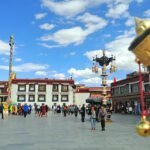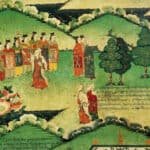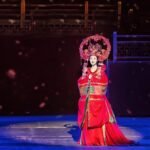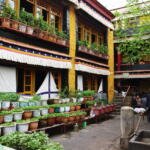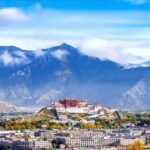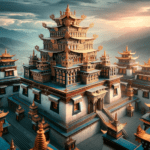Barkhor Street: Lhasa’s Historical and Cultural Heart
In every urban centre, there lies a historical lane that captures the essence of the city’s past and the stories of its people, similar to Beijing’s Chang’an Street, Chengdu’s Chunxi Road, and Chongqing’s Liberation Road. In Lhasa, this special avenue is Barkhor Street. A vintage lane that holds the memories of Lhasa, it embodies the history of Tibet’s snowy highlands.
The Spirit of Tibet in Barkhor Street
Barkhor Street, a circular street that encircles the Jokhang Temple, is known for its authentic Tibetan atmosphere. It’s a neighbourhood that transcends time and space, offering visitors a glimpse into Lhasa’s history. As a centre of faith, trade, and tourism, Barkhor Street welcomes a diverse mix of believers and travellers from across the globe.
A Path of Pilgrimage and Prosperity
Originally a pilgrimage path for worshippers at the Jokhang Temple, Barkhor Street has evolved into a vibrant thoroughfare. It’s lined with residential houses, shops, hotels, and workshops showcasing Tibetan handicrafts. Known in Tibet as “Barkhor,” meaning the middle turning path, it’s Lhasa’s oldest path of this kind, surpassing even the Jokhang Temple’s meridian corridor in significance.
A Blend of Tibetan Culture and Architecture
Less than six meters wide, Barkhor Street is flanked by ancient Tibetan courtyards, immersing visitors in the local lifestyle. This cultural corridor highlights Tibetan architecture, traditional supplies, colorful Thangka paintings, and delectable Tibetan cuisine, making it an essential visit for those keen to experience Tibet’s rich cultural heritage.
A Sacred Circuit of Devotion
Barkhor Street holds great spiritual significance for Buddhists. Devotees gather to walk around the street clockwise, their solemn prayers and steady footsteps filling the air with a sense of deep reverence. Engaged in mantra recitation, spinning prayer wheels, and prostrations, they are absorbed in devotion. This procession resembles a powerful turbine, spinning with ceaseless energy and faith.
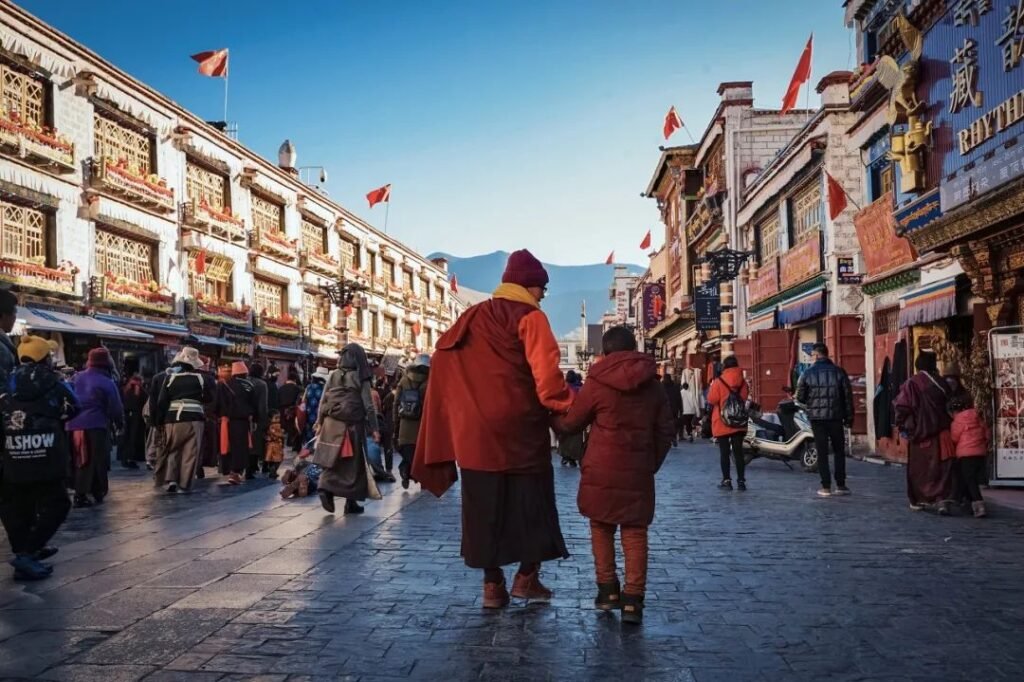
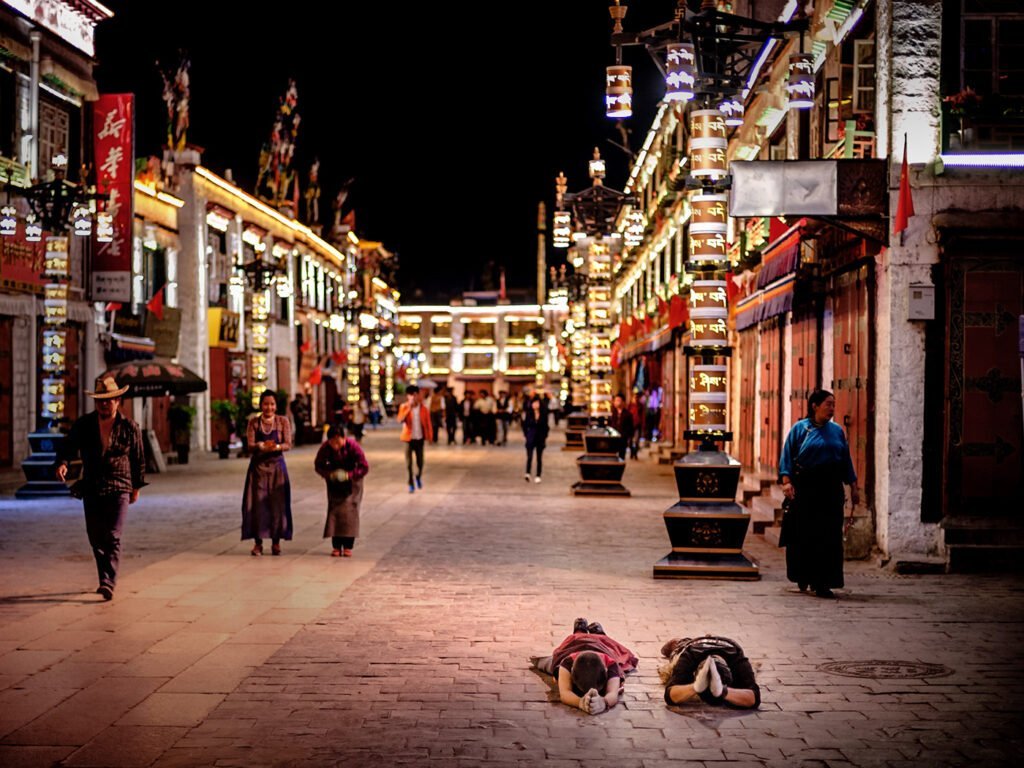
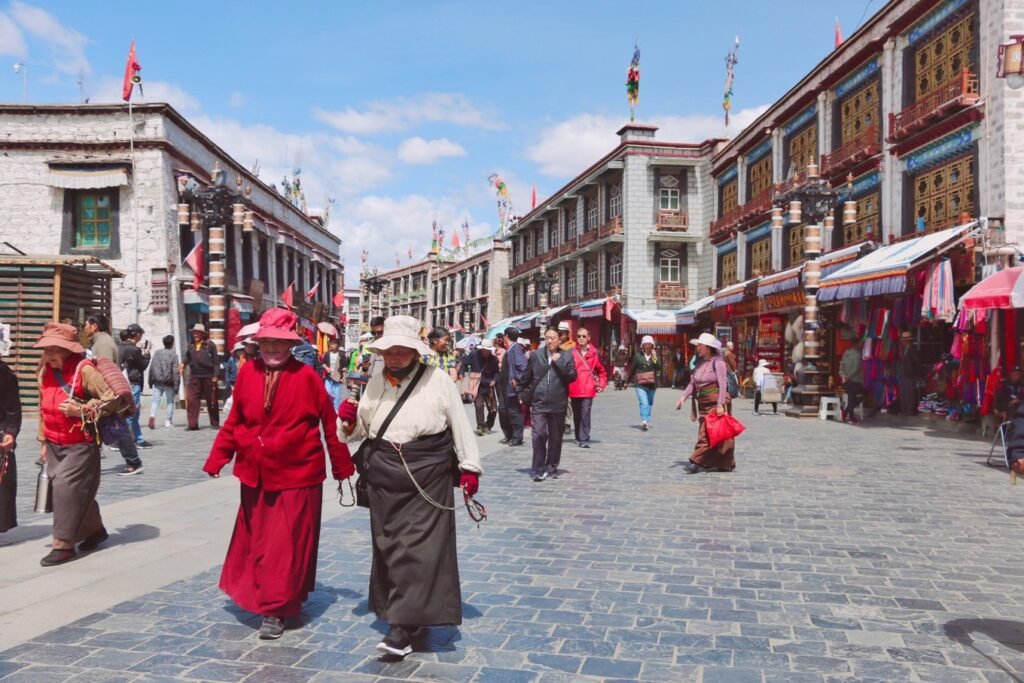
Jokhang Temple: The Spiritual Epicenter of Lhasa
Jokhang Temple, established in 647 A.D. by Songtsen Gampo, a renowned leader of the Tubo era, is not just centrally located in Lhasa but also forms the core of its social and spiritual life.
This temple was built to house a revered 12-year-old Buddha statue, brought by Princess Chizun of Nepal. The arrival of this sacred statue bestowed upon Lhasa the honorific title of “Holy Land,” transforming the city into the foremost pilgrimage site for Buddhists.
The inception of Jokhang Temple marked the beginning of a growing influx of devout Buddhists. For many, this site, known as the “nearest place to the Buddha,” became a cherished family legacy. Pilgrims from pastoral regions set up robust “black tents,” while valley inhabitants constructed simple adobe houses nearby. Over time, the profound spiritual aura of Jokhang Temple attracted even more followers.
The area around the temple blossomed with tents and adobe houses, some even mimicking the temple’s civil and stone architecture. This once haphazard settlement gradually evolved, with distinct areas emerging to reflect diverse regional cultures. Amidst this growth, the ancient city of Lhasa organically developed, with Jokhang Temple at its heart, shaping its cultural and religious identity.
The Tubo Dynasty and Songtsen Gampo: A Legacy of Expansion and Unification
The Tubo Dynasty, post the 7th century, witnessed a rapid expansion in its influence, largely due to the remarkable achievements of Songtsen Gampo.
Living only until the age of 33, Songtsen Gampo left an indelible mark on history. At just 12 years old in 629 A.D., he unified Tibet’s diverse tribes and established a new political system in Kyishod (now known as Lhasa). He introduced a written script, issued progressive decrees, and fostered the development of agriculture and animal husbandry. He also focused on building significant infrastructure, laying the groundwork for a prosperous future.
To cement the stability of his new regime, Songtsen Gampo made a strategic decision to introduce Buddhism into Tibet, where the Bon religion was predominant. His ambitions to unify the Qinghai-Tibet Plateau led to military engagements with the Tang Dynasty, marked by alternating victories and defeats for both sides.
Recognizing the need to balance internal governance with external expansion, Songtsen Gampo, a skilled politician, understood the importance of forging strategic alliances. He looked beyond warfare, recognizing that matrimonial alliances were an effective tool for diplomacy and cultural exchange. With a deep admiration for the Tang Dynasty’s advanced technology and culture, Songtsen Gampo sought to marry a princess from the court of Tang Taizong Li Shimin, further strengthening the ties between the two powerful dynasties.
Princess Wencheng: A Bridge Between Cultures
The Tubo Dynasty, under King Songtsen Gampo, twice sought marriage alliances with the Tang Dynasty, but Emperor Taizong initially rejected these proposals. Believing that Tuyuhun in the east had slandered him, Songtsen Gampo retaliated by seizing land and wealth from Tuyuhun.
In 636 A.D., Tubo approached the Tang Dynasty again for a marital alliance, only to be declined. Undeterred and confident in their strength to rival Tang Yi, Tubo expanded its territory, leading to a confrontation with the Tang army in Songzhou in 638.
Finally, in 641, Emperor Taizong agreed to the marriage, designating his daughter Wencheng to marry Songzan Gampo. Princess Wencheng’s marriage to Tubo in 641 marked the beginning of a generally harmonious and frequently communicative relationship between Tubo and the Tang Dynasty. Despite occasional frictions, the two empires maintained a cordial relationship. In 821 A.D., they pursued an alliance treaty, culminating in the erection of a monument in 823 A.D. by Zanpu Trisong Detsen in front of Jokhang Temple. The monument, inscribed in both Chinese and Tibetan, honoured the contributions of Princesses Wencheng and Jincheng and symbolized the “nephew-uncle relationship” between the two dynasties.
Tang Dynasty and Tibet Empire
Princess Wencheng significantly influenced the cultural exchange between the Tang Dynasty and Tibet. She introduced tools, medical equipment, and scriptures, as well as silkworm seeds, wine, paper, ink, and embroidery skills to Tibet. This exchange catalyzed Tubo’s cultural diversity and refinement in arts and crafts. Her contributions, which included opening the ancient Tang-Tibet road, promoting Buddhism, and advancing culture and technology, earned her the affectionate title “Gyamo Sa” among the Tubo people, meaning “fairy from the Central Plains.”
At 16, Princess Wencheng married Songtsen Gampo, who had four other wives from different regions of Tibet, reflecting a policy aimed at creating harmony both within Tibet and with the Tang Dynasty. After Songtsen Gampo’s death, Princess Wencheng continued to live in Tibet for 30 years until her passing, without having any children. Her legacy remains a testament to her role as a cultural bridge and peace ambassador between two great civilizations.
The Architectural Tapestry of Barkhor Street
A variety of Tibetan-style buildings, ranging from striking white-walled and red-roofed structures to simpler ones with dusty exteriors and crooked walls, adorn Barkhor Street, a hub of Tibetan culture. This bustling street serves not only as a residential and commercial center but also houses important governmental institution like the Kasha government, local courts, and prisons. It teems with a vibrant mix of shops, stalls, and workshops.
Barkhor Street also boasts numerous cultural relics and ancient architectural courtyards. Notable sites like Larang Ningba, Rabsey Tsenkang, Samdrup Podrang, Bomda Tsang, Tromsikhang, Drakang, and the Gendun Choepel Memorial Hall dot the street. These ancient buildings, bearing the marks of time, hold a place of honour on the street, cherished like precious family heirlooms.
Larang Nyingpa: A Testament to Tibet’s Rich History
Among these historical treasures is Larang Nyingpa, an ancient abode standing beside a millenary willow tree. Dating back to the Tubo period of Songzan Gampo, it is one of the oldest structures in Lhasa. The name “Larang” refers to a living Buddha’s residence, while “Nyingpa” indicates antiquity in Tibetan.
Originally known as ‘Tonpa’, Larang Nyingpa was the home of the creator of the modern Tibetan script and a distinguished minister during Songtsen Gampo’s reign. In the 15th century, it served as the residence of Master Tsongkhapa, a significant religious reformer and scholar in Tibet.
The 17th century saw the fifth Dalai Lama use this dwelling as a bedroom before moving to a newly constructed chamber in the Jokhang Temple. The room that once housed the fifth Dalai Lama was later named Labrang Nyingpa. Although its construction predates the Jokhang Temple, the exact date of its establishment remains a mystery. It’s believed that the blueprints for the Jokhang Temple were formulated within the walls of Labrang Nyingba. After liberation by the Chinese Red Army, it became the headquarters of the Chinese PLA in Tibet. With a history marked by the presence of numerous eminent figures, Labrang Nyingpa stands as a monument of significant historical and cultural importance in Tibet.
Rabsey Tsenkhang Temple: A Historic Sanctuary in Lhasa
Rabsey Tsenkhang Temple, one of the four significant Tsenkhang temples in Lhasa, stands alongside others like the Zima Guardian Hall in Dablin, Karmaxia, and Tengyeling Temple. Established during the reign of Songtsen Gampo, it also served as a residence for Princess Wencheng. During the 12th Dalai Lama’s era (1856-1875), the temple came under the administration of the Sera Monastery.
The Rabsey Tsenkhang, modest in size, consists of a single level and occupies the upper floor of its building. It is revered for its worship of the Dragon God. The main hall centers around the statues of the three mentors and apprentices of Zongkhapa, Master Padmasambhava, Tara, Drabji Lhamo, and other deities. A notable feature is the “soul stone” of Tuduo Wangqiu, the dragon god, located on the far left of the Buddha’s statue. Additionally, a slate bearing the footprints of Songtsen Gampo is preserved at the back of the stone.
Samdup Phodrang: A Monument of Tibetan History
White walls with distinct black trapezoid-shaped windows characterize the exterior of Samdup Phodrang, mirroring the style of many houses on Bakhor Street. Market stalls in front of the house present a lively glimpse of daily life, though security equipment partially obscures the view of this cultural monument.
Built-in 1642 for Gushi Khan, who led Kyoshud in conquering Tibet and establishing the Ganden Phodrang Government, Samdup Phodrang initially served as a luxurious residence. After Gushi Khan’s death, Heshuo’s influence in Tibet waned, and Sonam Dargey, the father of the Seventh Dalai Lama, made Samdup Phodrang his home.
In 1729, the Regent recognized Sonam Dargey’s abilities and responsibility, appointing him as a duke and granting him extensive lands, including the Samdup Phodrang mansion in Shannan. Following Sonam Dargey’s death, Emperor Qianlong conferred the duke title on the younger brother of the Seventh Dalai Lama. The Samdup Phodrang family, as one of Tibet’s four major families, plays a prominent role in the region’s history.
Pomdatsang: A Testament to Tibetan History and Architecture
Pomdatsang, an architectural marvel, stands as the most comprehensive edifice in the ancient city of Lhasa, with a rich history spanning over three centuries. In the Reting era, it was the residence of the Tibetan military commander. Until the late 1950s, Pomdatsang was a prominent commercial hub, extending its influence across Yunnan, Guizhou, Sichuan, and Tibet.
During wartime, its mule and horse caravans played a crucial role in establishing an international land transportation route. This feat provided significant support to the rear and garnered admiration both domestically and internationally. Today, Pomdatsang has been repurposed into a Tibetan-style hotel. Its ancient courtyard, complete with porch stones, iron flowers on railings, and the characteristic Senxia architectural design in the corridors, evokes the grandeur of the Tibetan aristocracy of bygone times.
Tromsikhang: A Window to Qing Dynasty’s Presence in Tibet
Tromsikhang, serving historically as the residence and office of the Amban (the Qing Dynasty’s representative in Tibet), provides a unique view of Barkhor Street’s history. The building’s south side, overlooking Baguo Street, earned the name “Chongsaikang,” which translates to “a house with a view of the market,” reflecting both its location and the lively atmosphere of Barkhor Street.
In the fifth year of Emperor Yongzheng’s reign (1727), the Qing Dynasty introduced the Amban system in Tibet. That year, Seng Ge and Mara took on the roles of the first ambassadors stationed in Tibet.
Today, Tromsikhang serves as an exhibition space, showcasing the history and influence of the Qing government’s Ambans in Tibet. Visitors can explore a collection of historical artefacts, official documents, scholarly works, and restored historical scenes as they walk through the ministerial gate and up the stone staircase. The exhibition hall, adorned with the phrase “Fuyuan Suijiang,” provides insights into the efforts of the numerous Ambans stationed in Tibet over 185 years. Their dedication to strengthening borders and building frontiers is a significant chapter in Tibetan history.
Gendun Chomphel Memorial Hall
Gendun Chomphel, a renowned Tibetan intellectual, poet, artist, interpreter and pioneer of humanism, was born in the spring of 1903 in Tongren County, Huangnan Tibetan Autonomous Prefecture, Qinghai Province. At the tender age of 4, he was recognized as a reincarnated spiritual child of the Dorji Drak Temple in Tibet. Subsequently, he pursued his studies in various monasteries and spent 12 years in South Asia. He passed away in Lhasa in 1951 on his 49th birthday.
The Garushak Courtyard located on Barkhor Street, served as the residence, and final resting place of Gendun Chomphel. In 2013, a commemorative museum dedicated to him was reconstructed at this site.
Daily Commodity in Tibetan Life
Barkhor Street thrives as a dynamic hub, hosting eminent individuals, aristocrats, and common folk alike. Not only do eminent monks and lamas grace this street, but it also attracts a multitude of devotees. Alongside intellectuals and sages, numerous artisans such as carpenters, silversmiths, blacksmiths, painters, tailors, and other craftsmen frequent the street. Stalls, tents, and small shops line the street, bustling with colourful transactions carried out by these people.
The street resonates with echoes of a bygone era, adorned with handicrafts like Tibetan scriptures, incense, knives, rings, earrings, bracelets, traditional attire, and other artefacts. Here, one can witness the unique manual production methods of the Tibetan people, gaining a deeper appreciation for their vibrant and diverse lifestyle. Known for their warm hospitality, the locals make this street a focal point of Tibetan social life. It stands as the most concentrated, prominent, and profound center of Tibetan social life.
The Essence of Tibetan Life: Incense and Teahouses
In Tibet, whether in temples or homes, a rejuvenating aroma pervades the air, a scent that enlivens the senses. This fragrance, a blend of grass and butter from the grasslands, emanates from Tibetan incense, creating a sense of vitality and invigoration.
Mindroling Tibetan Incense: A Fragrance of Heritage
Mindroling Temple, established in 1670 in Shannan and the ancestral court of the Nyingma School, gave rise to Mindroling Tibetan incense, one of the three major types of Tibetan incense. Reserved historically for the Potala Palace, Mindroling incense boasts a prestigious status.
The production process of Mindroling Tibetan incense adheres to an ancient recipe from Buddhist scriptures. Artisans meticulously blend over 30 precious medicinal ingredients, spices, gold, silver, and other precious minerals, avoiding any artificial fragrances. This complex and entirely handmade process limits the annual production, thereby enhancing its exclusivity.
Lighting Mindroling incense purifies the air, prevents illness, and offers a calming, soothing effect, enriching the atmosphere in a way that is hard to describe. Its value and significance evoke the serenity of a gentle mountain stream or the pristine snow of the Himalayas, symbolizing purity and tranquility.
Woeser Gamchung Teahouse: A Hub of Lhasa’s Daily Life
In the heart of Lhasa’s temple and market streets, Guangming Gamchung Teahouse stands as a cornerstone of civilian life. If Barkhor Street is the heartbeat of Lhasa, this teahouse is its lifeblood. Here, a diverse crowd of merchants, monks, civil servants, artisans, pilgrims, and tourists converge, creating a vibrant tapestry of life.
The teahouse’s Tibetan-style façade gives way to a simple, industrial interior. Patrons can sit anywhere, pay with loose change, and enjoy endless refills of tea in a relaxed atmosphere. The space, though modest and dimly lit, buzzes with activity. Long tables and benches offer a serene spot for quiet reflection or engaging conversations with strangers.
Guangming Sweet Teahouse, known for its affordability and friendly ambience, is a cherished local spot. It mirrors the role of teahouses in Chengdu or cafes in Paris, becoming a daily retreat for leisure and socializing. In Lhasa, numerous teahouses dot the city, each frequented by countless locals and visitors, embodying the essence of Tibetan community life.

